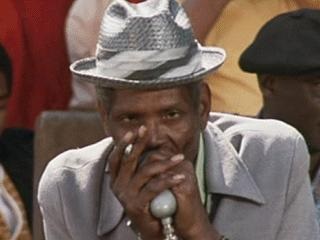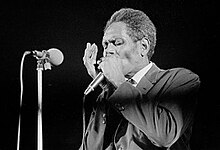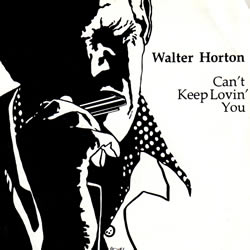Big Walter’s Boogie – Walter Horton
This is THE showcase blues harmonica number which every journeyman player needs to learn. It’s a catchy melody in its own right, but it is particularly attractive when played on the blues harp. And what makes it so important to a player’s development is that, while it incorporates the essential elements of a good harmonica boogie, it offers a concise blueprint for circuiting the 12 bar format without ignoring chord changes and clinging to special effects. In other words it promotes the art of blues musicianship – how and what to play over the I, IV and V chords.
There is no doubt that emulating Big Walter’s delivery demands a great deal of precision. You will need to master a range of techniques including tongue fluttering, octaving, puckering, tongue blocking, tongue slapping and accurate bending. All of which are sustained with excellent breath control. And above all else, you’ll have to nail that BIG tone. Take your time, pay attention to the technique and detail, and you can master this show stopper for yourself.

It is worth noting that there are several recorded versions of this tune, all of which vary slightly. Indeed you can hear Big Walter snatching a breath during the fluttered intro on one take, so maybe he was as human as the rest of us after all. Here’s how to master the essentials..
How did he do it?
You’ll need an A major diatonic harp and you’ll be playing in the cross harp key of E (2nd position). I am referencing the recording on the Can’t Keep Lovin’ You album (Blind Pig Records). We’ll cover the essentials here, but be aware that each section is a lesson in itself. At each stage, listen to the original a few times to get your ear muscles working and see if you can internalise Walter’s delivery. Next, strip down what you hear to find the pathway notes. Now build it up incorporating Walter’s rhythm and tonality. Finally, and just as important, finish the job with the textures and decorations that Walter employs; glissandos, growls, slaps and hand effects are just a few.
Intro and tumble down
If we strip the opening section down to its bare bones, our pathway notes are 4D 5D 4D 5D 6B 7D. Run these up and down a few times first to anchor the melodic structure.

Now let’s build this into something more recognisable. The intro uses the tongue flutter, shimmer or dabbing technique. Many blues players apply this to long notes for its rhythmic and tonal qualities, especially when amplified. It’s often applied to the intro of harmonica boogies, or for texture on the final note of a piece. We need to perfect this technique for Walter’s Boogie.
In effect it is tongue blocking across 4 holes, while rapidly opening and covering the lower holes to produce an intermittent chord. This is achieved with an on-off application of the underside of the tongue, not a lateral sweep or trill, and it’s delivered to a subtle triplet rhythm. At each step, it also gives precedence to the melodic note (pathway note shown above). When we apply a flutter, we are not poking out a rigid tongue, but flattening and relaxing it, and using the underside of the front end to detect the central divider of our target holes. Here are the tabs.
Key: 3D’ first draw bend / 1D=4D fluttered block / ~4D bend into the note / 1B-4B four hole split / 2B..3B connected notes / 4B.. sustain
3D’ 1D=4D
2D=5D
1D=4D
2D=5D
3B=6B
4D=7D
gliss..9B..9D 8D..9D..8D..7D..6D 6B..5D..4D..3D’

To begin learning this technique, touch the underside of your upper lip with the widened tip of your extended tongue and say la-la-la, la-la-la. Count one–two-three, two-two–three in your head as you do so. This will create a triplet rhythm. Now do this breathing in. Next, pick up your A harp and cover holes 1D:4D with your embouchure, ensuring the harp is pushed well into your mouth for tone. Dropping your jaw will help. Draw in breath and apply the tongue flutter. Once you coordinate all this, listen out for the optimum tonal position and adjust accordingly. You will recognise this by its chunky sound quality. Relaxing and letting the harp resonate adds the final touch.
Another vital aspect of the opening delivery is good breath control. If you relax enough and let the harmonica do the work, you can cover the first four bars using one air intake, and still maintain enough tone. To give yourself a fighting chance, have a conscious exhale to empty your lungs before launching into the piece. You then have the blow section in bar five to decompress, before completing the 4D=7D flutter in bar six.
Finally let’s consider rhythm, accents, dynamics and tempo; in other words the groove. Note that Walter delivers an underlying rhythm to the intro, first by applying his flutters in triplets. He accents the first beat of each triplet like so 1-2-3, 2-2-3, 3-2-3, 4-2-3, which creates a 12/8 time signature. Simultaneously, as he passes between the drawn positions in 1D=4D and 2D=5D, he accents the downbeat of each bar with a snatch or micro-glissando. Then, when he switches to the blown position in 3B=6B, we hear an audible glissando, before the final snatch into 4D=7D. Walter’s glissando into 3B=6B affords him maximum opportunity to exhale after the lengthy inhale across the preceding four bars. Note that he also crescendos at this point, because he can, and carries the louder dynamic into the final bar. in contrast, let’s reflect on the level of dynamic Walter actually opens with. It is piano. This has a dual function. It creates musical interest by providing space for the intro section to grow dynamically. It also affords the lung capacity required for continuity of technique across the first four bars.

And finally, coming in at the optimum tempo is going to improve your chances of survival in the first four bars, while selecting a good rate of shuffle for the rhythm section, audiences and dancers. Walter comes in at about 129bpm. Anything faster will sound rushed. Anything slower means you won’t clear with the first four bars in one breath. But don’t obsess on this particular point, there are recorded examples where Walter himself doesn’t quite make it.
The first flutter is over the 1D=4D draw chord. After four triplet beats, and using the same breath, he moves up to the 2D=5D draw chord, introducing the flat 7. He then repeats this 1D=4D and 2D=5D chord sequence, still using the same breath, before exhaling through the 3D=6D blow chord. Finally he moves up to the draw 4D=7D. In this final draw chord he plays two triplets followed by two accented notes, 1-2-3, 2-2-3, 3, 4.
Lessons and donations
All of which indicates just how much ther0e is to consider if we really want to develop our chops and emulate a blues master at work. From here on we will avoid this level of detail, but feel free to raid the tabs and use your own ear muscles to finish the job. We just ask that you show your appreciation for the hours of work this has taken with a PayPal donation by pasting this address into your browser paypal.me/harpsurgey, Alternatively, book in for a lesson with Richard Taylor at the Harp Surgery and we’ll gladly show you the ropes. Lesson information is here.
Opening sequence
Now into the signature sequence, starting over the I chord. It’s easiest if you switch between a pucker on the 3 hole and tongue block on the 5 and 4 holes, adding tongue slaps as you work down. The first note (3D’) is accented and launched ahead of the beat for impact.
3D’..3D 5D 5B 4D
3D’..3D 5D 5B 4D
3D’..3D 5D
3D’..3D 5D
3D’..3D 5D..4D..5D 5B..4B..5D 4D
2D”..2D 3D’..2D..3D’ 3D”..2D..3D”
3B.. 2B..3B 3B..2B..3B
3D’..2D..3D’ 3D”..2D..3D”
3B..2B..3B 3D..2D..3D
5D..4D..5D 5B..4B..5B 4D
3D..3D 5D..5D 5B..5B 4D..4D 5B
1D..1D 2D”..2D’ 4D..4D 4B..4B
1B..1B 2B..2B 2D 3D”..2D 2D”..1D
2D 1D 1B..1D
2D 2D”..1D 1D
And back again
3D..3D’..3D 5D..5D 5B..5B 4D
3D’..3D 5D..5D 5B..5B 4D
3D’..3D 5D
3D’..3D 5D
3D’..3D 5D..4D..5D 5B..4B..5D 4D
2D”..2D 3D’..2D..3D’ 3D”..2D..3D”
3B..2B..3B 3B..2B..3B
3D’..2D..3D’ 3D”..2D..3D”
3B..2B..3B 3D..2D..3D
5D..4D..5D 5B..4B..5B 4D
3D’..3D 5D..4D..5D 5B..4B..5B 4D..4D 5B
1D..1D 2D”..2D’ 4D..4D 4B..4B
1B..1B 2B..2B 2D 3D”..2D 2D”..1D
2D 1D 1B..1D
2D 2D”..1D 1D
Second sequence
gliss..6B..6B..
gliss..6B..6B..
gliss..6B..6B 5D..5B 4D
3D’ 3D” 2D
2D” 2D” 2D”..2D’
gliss..6B..6B..
gliss..6B..6B..
gliss..6B..6B 5D..5B 4D
3D’ 3D” 2D
2D 3D..4D..5B 5D..5D 5B..5B 4D..4D 4B..4B
6B..6B 5D..5B 4D
3D’..3D” 2D
2D..1D..2D 1D 1B..1D
2D 2D”..1D 1D
Signature sequence variation
3D’..3D’..3D’ 5D….
3D’..3D 5D..5D 5B..5B 4D
3D’..3D 5D….
3D’..3D 5D..4D..5D 5B..4B..5B 4D
2D”..2D 3D’..2D..3D’ 3D”..2D..3D”
3B..2B..3B 3B..2B..3B
3D’..2D..3D’ 3D”..2D..3D”
3B..2B..3B 3D..2D..3D
5D..4D..5D 5B..4B..5B 4D
3D’..3D 5D..4D..5D 5B..4B..5B 4D..4D 5B
1D..1D 2D”..2D’ 4D..4D 4B..4B
1B..1B 2B..2B 2D 3D”..2D 2D”..1D
2D 1D 1B..1D
2D 2D”..1D 1D
Breakout section
~3D..4D ~3D..2D
1D 2B..2D ~3D ~3D..3D”..2D
1B..2B..3B..3D”..
1D..2B..2D ~3D ~3D..2D..
3D’..3D’ 4D 5D..4D 4B.4B.
~4D ~4D ~4D ~4D.. ~4D 2D…
1D 1B..1D
2D 2D’..1D 1D
Signature section
~3D..4D..2D-5D
2D=3D..4B ~3D..1D-4D
~3D..4D2D-5D..2D-5D 2B-5B..2B-5B
1D-4D..1D-4D 1B-4B..1B-4B
3D’ 3D”..2D 2D”..1D 1D’..1B
3D’..2D..3D’ 3D”..2D..3D”
3B..2B..3B 3B..2B..3B
3D’..2D..3D’ 3D”..2D..3D”
3B..2B..3B 3D..2D..3D
5D..4D..5D 5B..4B..5B 4D
3D’..3D 5D..4D..5D 5B..4B..5B 4D..4D 5B
1D..1D 2D”..2D’ 4D..4D 4B..4B
1B..1B 2B..2B 2D 3D”..2D 2D”..1D
2D 1D 1B..1D
2D 2D”..1D 1D
Second sequence in brief
6B..6B
6B..6B
6B..6B 5D..5B 4D 3D’..2D..
6B..6B
6B..6B
6B..6B 5D..5B 4D 3D’..3D”..2D
2D 3D..4D..5B
5D..5D 5B..5B 4D..4D 5B
gliss..6B 5D..5B 4D 3D’.. 2D
Outro
6B 5D 5B 4D 4B 3D’
6B 6B..6B 5D..5B 4D..4B 3D’
1D..2B 2D”…..
And there you have it. As mentioned earlier, there are several recordings of Walter’s Boogie, each one slightly different. But this will stand you in good stead and provides all the essentials you need.
Lessons and donations
Once again we ask that you show your appreciation with a PayPal donation by pasting this address into your browser paypal.me/harpsurgey Alternatively, book in for a lesson with Richard Taylor at the Harp Surgery and we’ll gladly show you the ropes. Lesson information is here.



Hi!!!!
Fantastic this tab and explanation!!!!!!!!!!!!
very clear and detailed!
i have a question about a tecnique i hear in that version of walter boogie:
at about 1.00” on the 6B he did a pick-up that looks like a glissando,
but it’s not a glissando , i hear like “TRRRRRRRRR”……
can you tell me what he did?
Thanks
BestRegards
Marko
Hi Marko. Thrilled you’ve enjoyed the tab. I hope to spruce it all up soon and record some video lessons too. I’ve checked the point you mention and you’re right. It’s a small detail, it’s easily overlooked, but it’s one which is intrinsic to Walter Horton’s playing. It’s not a glisssando as you point out, but there is a rolled percussive effect complete with Horton’s whopping tone behind it.
As far as I can tell it’s produced by a huff or pull slap. This is all part of the tongue-block technique. You start by huffing or playing the group of blow notes in that area of the harp 4B-5B-6B. As the reeds respond, you then close off the holes you don’t need with your tongue until you’re just left with 6B. This all happens in one relaxed, natural, but quick movement. When combined with whatever mic and/or amplification Horton used, the result is the sound you’ve identified.
I hope this helps.
THANKS!!! Really helps and the best discussion tab of this great song
thanks for this! really heps! best tab of this amazing song!:.. just in case do you have any backingt track?
Thanks Mariano. Glad you enjoyed it. Pssibly my facourite ever harp piece. I haven’t found a backing track to this yet..sorry :0( Doc
Thanks for a tab. It’s also my favourite. I,m learning other two variations available on YouTube. Impressive hand effects there
Excellent tab. Thanks to you all! Now living in Patcham having eventually moved from Suffolk. Continuing with my beginner/improver practice and still loving it. Looking forward to catching up, post COVID. for some live workshops.